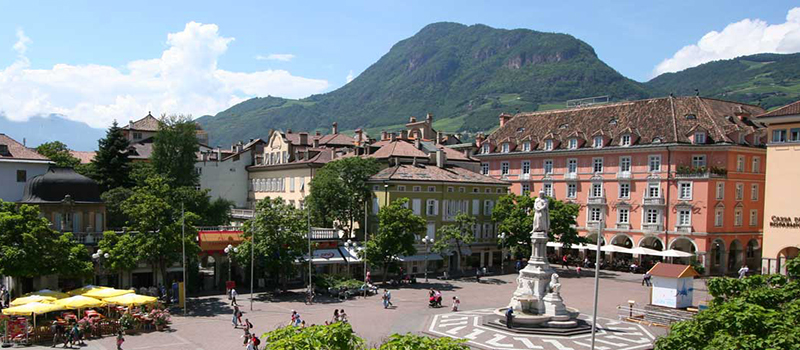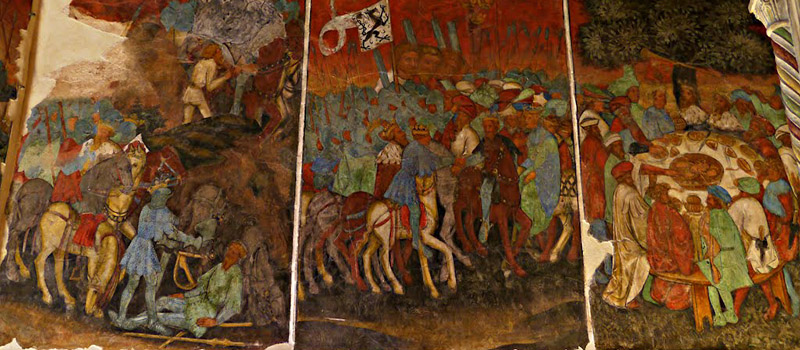-
Guided city tour of Bolzano
The Gateway to the Dolomites
Bolzano (chief town of province Alto Adige – South Tyrol, Italy), once city of merchants, is today also city of art, show, culture, exchange and vacation. For its location the city is also called “the Gateway to the Dolomites”.
Our expert guide will lead you through the charming narrow streets, past architectural gems and the landmarks of the historical center of the city. Please don’t hesitate to ask your guide to introduce you the city he/she knows and loves! You might discover and experience something completely new!Details
Period: available all year
Duration: 4 hours
Meeting Point: Hotel of the guests / Piazza Walther
Starting Point: Piazza WaltherItinerary
Walther Square
The Piazza Walther, also known as the “drawing room” of the town, was completed in 1808 by order of King Massimiliano di Baviera, and initially named after him. It was later given the name of the Archduke Giovanni d’Austria (Johannesplatz) and, in 1901, it was dedicated to Walther von der Vogelweide (1170-1230), one of the great German poets and storytellers of the Middle Ages. After the annexation of Alto Adige to Italy, the square was named after King Vittorio Emanuele III and, only in the second part of the post-war period, the name of the German poet was resumed. A monument to Walther, of neo-Romanesque style, sculpted in white Lasa marble by the Venostan sculptor Heinrich Natter (1889), dominates the centre of the square. In 1935 the fascist authorities had it transferred to a more secluded part of town (Rosegger Park – via Marconi). The monument was later relocated in the square in 1985.
Cathedral
On the same square we will admire the Cathedral of Bolzano, a late Medieval and a Romanesque Basilica (1180). After one century the site has opened into a new imposing construction, completed around 1420, synthesizing, over a few decades, the intervention of Lombard mastery with the Gothic style of the Suevian mastery. The bell tower, with an open fretwork spire in sandstone, which stands 65m tall, was built by the Suevian architect, Hans Lutz von Schusseried, between 1501 and 1519.
Vicolo della Pesa
Various alleys and through roads link via Portici with the backstreets and parallel roads, Dr. Streiter and Argentieri. Take one of these, vicolo della Pesa, and you can reach piazza del Grano, where the farmers’ market was once held.
It is one of the oldest places in Bolzano, once hosting the castle of the Prince-Bishops of Trento (destroyed in 1277 by Mainardo II di Tyrolo) and the church of Sant’Andrea (destroyed in 1785). One of the most picturesque buildings of the city is situated to the north of this square: la casa della Pesa (1634), public weigh-house until 1780.Casa della Pesa
It is a beautiful building dating back to 1634, hosting the public weigh-house until 1780. Part of the ancient wall can still be seen on one side. Opposite the building a plaque commemorates the church of Sant’Andrea (destroyed in 1785) and further on you can admire the picturesque Piazza del Grano, embellished by shops and restaurants, once hosting the market of wheat and other agricultural produce. It was the first urban centre in Bolzano, with its castle of the Prince-Bishops of Trento, founders of the city. The castle was probably destroyed by Mainardo II di Tyrolo during one of his assaults to obtain control of such an important market town (1277).
Via e piazza della Mostra
Via and piazza della Mostra: with the prestigious palaces of Campofranco (corner between piazza Walther and courtyard) and of Menz and Pock, hosting the glamorous hotel and now restaurant “Zur Kaiserkron'”. The town jail, with the prison guard accommodation, used to be below the Fink inn.
Portici (Arcades)
Once the heart of the medieval village, they have kept this characteristic to date with their seamless continuity of shops, some typical and traditional, others chic and modern. The façades are a joyful sequence of different architectural traits: erker (murals), stucco decorations, pastel colours, the balcony of palazzo Mercantile, arcades alternating in various heights and decorations. The Old Townhall arcades, now centre of the Archivio Storico Comunale, are particularly beautiful with their pointed arches and fresco decorations. The back streets linking parallel roads are also of interest as they show the architectural sequence of buildings and the various uses of living spaces (shops, stores, cellars, halls, laboratories are some examples).
Piazza del Municipio (Town Hall Square)
Piazza Municipio is enclosed by the charming town hall palaces to the south (in neo-baroque style with interesting frescoes in the sala del Consiglio – 1907) and by Casa Amonn to the east (façade decorated with rococo style stuccoes and fresco decorations on the remaining buildings), represents the beginning of the Arcades and is often centre for exhibitions.
Via Bottai (Coopers street):
Via Bottai is one of the most characteristic streets of the town centre with its beautiful ironwork signs, inns and the historical hotel Luna Mondschein. The Natural Science Museum (see museum route) is situated at the end of the street in what used to be the administrative office of Massimiliano I, Emperor and Count of Tyrol (built in 1512). The old inns “Cavallino Bianco” and “Ca’ de Bezzi”, a favourite destination for many artists, are right next to the Museum.
Via Joseph Streiter
Via Joseph Streiter was named after the poet, jurist and mayor of Bolzano in the second half of the XIX century. It corresponds to the north moat of the medieval village and the buildings on the south side correspond to the buildings of the north side of the arcades. The first part of the street is very attractive, especially in the summer: an open-air bar, shops, restaurants and decorations next to the fish stalls create a unique atmosphere. Many arches running through the street give it a medieval character. Number 25 was the entry to the old Townhall.
Franciscan Church and Convent
Franciscans settled in the town in 1221; the present building dates back to the first half of 1300, but the original ceiling, flat and with a polygonal choir, has been replaced by fifteenth-century’s vaults.
The cloister is a perfect Gothic example replacing the Romanesque style one of the first construction. There are many frescoes of different ages with examples of the Giotto school of 1600 and 1700. The church has a magnificent wooden altar by Hans Klocker of Bressanone dedicated to the Nativity (painted wood – 1500).Piazza delle Erbe
The colourful and lively piazza delle Erbe, heart of the city centre, hosts the famous fruit and vegetable market daily (except on Saturday afternoon, Sunday and public holidays).
The Neptune fountain, with a statue with his trident and bronze shells, by G. Mayr di Fiè (1745), is on the corner with via Portici. It has been classified amongst the one hundred most beautiful fountains in Italy and is also called “Gabelwirt” (Innkeeper with fork).
On the corner with Via Museo a plaque on the façade of the neo-Gothic building, commemorates the old “Al Sole” hotel where eminent personalities such as Goethe, Herder and Emperor Giuseppe II, resided between 1783 and 1790.Via Argentieri:
Via Argentieri: parallel to the Arcades, used to be the south moat. From here you can clearly see the entry to the Mercantile Museum of the palace with the same name, then Casa Troilo, with its fresco and angular turret and a narrow link to the Arcades.
Dominican church
The Dominican friars settled in Bolzano in 1272 and had their church built with one nave only inside a large convent comprising different chapels, some of them destroyed, and a magnificent cloister. A part of the ancient structure is today’s Music Academy, which hosts the prestigious International piano competition, Ferruccio Busoni, of the Civic Gallery, centre of exhibitions and other important cultural events and institutions.
Gothic vaults and baroque elements were added to the church in 1600 and 1700 (to the left of the high altar you can see the pala del Guercino commissioned by the town merchants). The church has many precious examples of Bolzanine painting of 1300 on the eastern side of the cloister and on the west wall of the church. However, the jewel of the entire complex is cappella di San Giovanni, a long and narrow side chapel with the most magnificent fresco cycle of the Giotto School in the province. Dedicated to San Giovanni after the name of the Florentine head of the de’Rossi family, naturalized von Botsch who commissioned its decoration. The scenes from San Nicolò’s life on the last register of the east wall are of particular interest, as well as the ‘Triumph over Death’ fresco in the first register of the same wall, the Escape to Egypt on the west wall and San Bartholomew’s torture on the north wall. The seamless frescoes throughout the chapel are superb examples of the local art in the 1300.
In the adjacent cloister (entry from piazza Domenicani) you can admire some frescoes by Friedrich Pacher which can be dated to 1496.
-
Don't miss too..





